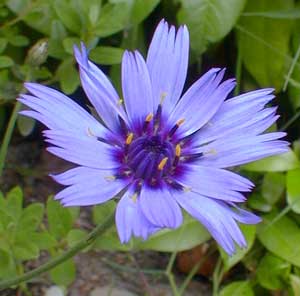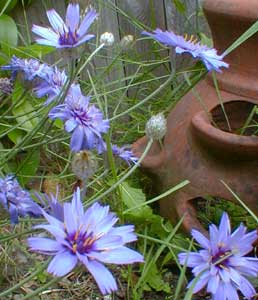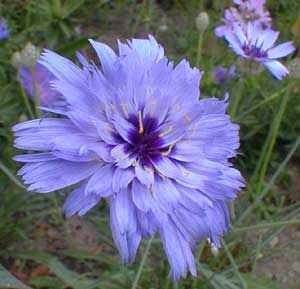
Cupid's Dart; aka,
Blue Cupidone; or,
Blue Succory
"By Hymen's torch, by Cupid's dart,
By all that thrills the beating heart;
The bright black eye, the melting blue,
I cannot choose between the two."
-Oliver Wendell Holmes,
1809‚1894
1809‚1894
The Cupid's Darts (Catananche caerulea) we planted four or five years earlier had already for some while died out of the garden, when we decided to start three more clumps.
It wants full sun in loose well-draining soil & is moderately drought-tolerant, though it will need some water at the height of summer. The plant will rot & disappear if it remains too wet in winter, or if soil is in general too clayey. Even in the best of conditions it is shortlived & may need to be replaced about every three years.
 Originating in Mediterranean Europe & northern Africa, Cupid's Dart grows wild in wastelands & on mountain heights, being very cold-hardy because of its subalpine adaptations. It can be grown from seed sewn in late winter or early spring, & will bloom even its first year, blooming from midsummer to first frost. For its second year it becomes a sizeable clump two feet tall with loads of long-lasting flowers late spring & throughout summer & into the early part of autumn.
Originating in Mediterranean Europe & northern Africa, Cupid's Dart grows wild in wastelands & on mountain heights, being very cold-hardy because of its subalpine adaptations. It can be grown from seed sewn in late winter or early spring, & will bloom even its first year, blooming from midsummer to first frost. For its second year it becomes a sizeable clump two feet tall with loads of long-lasting flowers late spring & throughout summer & into the early part of autumn.Flowers are two- to three-inch, frilly blue to lilac-blue, with dark heart & silvery paper-like bracts, about halfway between a daisy or cornflower & a scabiosa. They are good as cut flowers, & suitable for drying. The leaves are grassy & pubescent.
The first two photos (snapped in June) are of a clump that produces blue daisy-like flowers that could be called "singles," but the third photo below (snapped about mid-July) shows a typical flower from another clump, which could be called a "double." Sometimes these singles & doubles appear on the same clump, so they are not distinct cultivars. Even so, some clumps are chiefly doubles & other clumps rarely to never have so many petals per bloom. There doesn't seem to be any way of insuring the more impressive number of petals, but it's a gorgeous & reliable long-term bloomer in either case.
The genus name is adpated from the Greek name for this plant, Katananke, which means to "forced down against choice" or "compulsion," as it was believed to be the "date rape" drug of its day. It is called Cupid's Dart even now because the Greeks & Romans used the plant in magic love filtres, slipped discretely into the diet of an object of affection in insure one's interest was reciprocated. Or perhaps the potion was not given discretely, since curioiusly enough it has no actual drugging effect, & any effect it did have was strictly the cause of a shared religious or mythological belief.
 The modern attitude toward Eros & Aphrodite is rather wussier than the attitude in the ancient world, where it was known that love had felled nations, & Heracles arrow could not have slain Nessus except that his heart was first pierced by Cupid's dart. Thus Ovid in the Metamorphosis makes Cupid's dart the source of despair & icy terror.
The modern attitude toward Eros & Aphrodite is rather wussier than the attitude in the ancient world, where it was known that love had felled nations, & Heracles arrow could not have slain Nessus except that his heart was first pierced by Cupid's dart. Thus Ovid in the Metamorphosis makes Cupid's dart the source of despair & icy terror.Even Aphrodites redolent rose had thorns, & the blue flower of her only son was the same color as the hair of the Furies, or of cloudy cloth that Thanatos laid over the dead, & of the war-chariot of Poseidon, & of the Sea itself from whence his mother arose. The flower may have gained an association with Eros because the flower was the same color as the eyes of the Kharites, or Graces, the constant companions of his mother. A Greek poetic fragment speaks of the susceptibility of the blue-eyed nymphai to Eros. The Kharites with Eros, Aphrodite, & Dionysios held orgies in mountain heights. Which perhaps only coincidentally is where the Cupid's Darts bloom.
Aphrodite urania was herself a bright blue, as was Uranus from whose blood spilled upon the sea Aphrodite arose. Upon a mountain peak when She took lovers, they were afterword slain, or castrated, just like blue-skinned Uranus. In these myths surrounding the color blue, it can be seen that there is something dour & doomful, hence as a love-potion the flower Cupid's Dart was believed often to be a prelude to nothing better than rape.